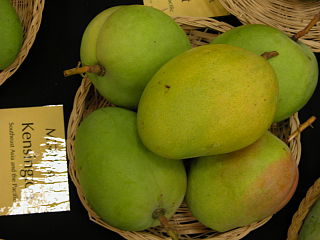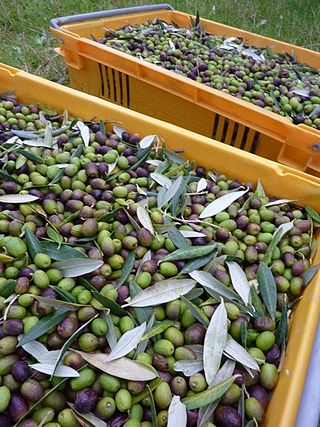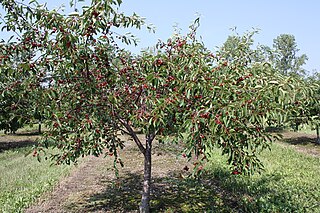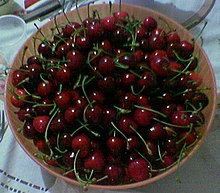
The almond is a species of small tree from the genus Prunus, cultivated worldwide for its seed, a culinary nut. Along with the peach, it is classified in the subgenus Amygdalus, distinguished from the other subgenera by corrugations on the shell (endocarp) surrounding the seed.

A cherry is the fruit of many plants of the genus Prunus, and is a fleshy drupe.

Prunus cerasus is a species of Prunus in the subgenus Cerasus (cherries), native to much of Europe, North Africa and West Asia. It is closely related to the sweet cherry, but has a fruit that is more acidic. Its sour pulp is edible.

A clementine is a tangor, a citrus fruit hybrid between a willowleaf mandarin orange and a sweet orange, named in honor of Clément Rodier, a French missionary who first discovered and propagated the cultivar in Algeria. The exterior is a deep orange colour with a smooth, glossy appearance. Clementines can be separated into 7 to 14 segments. Similar to tangerines, they tend to be easy to peel. They are typically juicy and sweet, with less acid than oranges. Their oils, like other citrus fruits, contain mostly limonene as well as myrcene, linalool, α-pinene and many complex aromatics.

Mirabelle plum is a cultivar group of plum trees of the genus Prunus. It is believed that the plum was cultivated from a wild fruit grown in Anatolia.

An orange is a fruit of various citrus species in the family Rutaceae ; it primarily refers to Citrus × sinensis, which is also called sweet orange, to distinguish it from the related Citrus × aurantium, referred to as bitter orange.

Rainier is a cultivar of cherry. It was developed in 1952 at Washington State University by Harold Fogle, and named after Mount Rainier. It is a cross between the Bing and Van cultivars.

Diospyros kaki, the Oriental persimmon, Chinese persimmon, Japanese persimmon or kaki persimmon, is the most widely cultivated species of the genus Diospyros. Although its first botanical description was not published until 1780, D. kaki cultivation in China dates back more than 2000 years.

The Evans Cherry also sold under the name 'Bali', is a sour cherry cultivar rediscovered in an old orchard near Edmonton, Alberta, Canada, and is significant because cherries were not considered viable in the harsh climate of the Canadian prairies, yet the specimen, discovered by Ieuan Evans, had been growing there since the 1920s. Grown on its own rootstock and self-pollinating, the Evans Cherry displays white blossoms in spring and bears abundant fruit.

Griotte de Kleparow is a dark-red morello, or Griotte, type of cherry which originated from the outskirts of Lviv, modern Ukraine.

Indonesia was the fourth-largest producer of coffee in the world in 2014. Coffee cultivation in Indonesia began in the late 1600s and early 1700s, in the early Dutch colonial period, and has played an important part in the growth of the country. Indonesia is geographically and climatologically well-suited for coffee plantations, near the equator and with numerous interior mountainous regions on its main islands, creating well-suited microclimates for the growth and production of coffee.

The Ulster cherry is a sweet cherry cultivar that originated in the United States.

Prunus avium, commonly called wild cherry, sweet cherry, gean, or bird cherry is a species of cherry, a flowering plant in the rose family, Rosaceae. It is native to Europe, Anatolia, Maghreb, and Western Asia, from the British Isles south to Morocco and Tunisia, north to the Trondheimsfjord region in Norway and east to the Caucasus and northern Iran, with a small isolated population in the western Himalaya. The species is widely cultivated in other regions and has become naturalized in North America New Zealand and Australia.

The 'Kensington Pride' mango is a named commercial mango cultivar that originated in Australia. It is sometimes called the KP, Bowen or Bowen special. It is Australia's most popular mango, accounting for over 80% of the country's annual commercial mango market. It is considered to have a distinctive flavour and aroma when compared with the Florida-bred cultivars grown by most mango-exporting countries.

The Leccino olive is one of the primary olive cultivars used in the production of Italian olive oil. Across Italy, it is one of the primary olive cultivars found in olive groves. It is believed to have originated in Tuscany, and it is now grown all over the world. Due to its delicate flavor, the olive oil it produces is commonly blended with Frantoio, Coratina, Moraiolo and Pendolino in order to create more flavor.
Little cherry disease or LChD, sometimes referred to as little cherry, K & S little cherry or sour cherry decline, is a viral infectious disease that affects cherry trees, most notably sweet cherries and sour cherries . Little cherry disease should not be confused with cherry buckskin disease, which is caused by Phytoplasma. Note that both diseases are among the diseases referred to as cherry decline.
The Chelan cherry is a cultivar of cherry. It is a hybrid of the Stella and Beaulieu varieties first developed in Prosser, Washington.

Stella is a cultivar of cherry developed in British Columbia, Canada. It is notable as the first self-fertile sweet cherry to be named. It has been awarded the Royal Horticultural Society's Award of Garden Merit.
Van is a cultivar of cherry originating from Canada.

The Balaton cherry is a cultivar of sour cherry native to Hungary, where it was originally named Újfehértói Fürtös. It was introduced to the United States in the 1980s and is now grown there commercially.


















